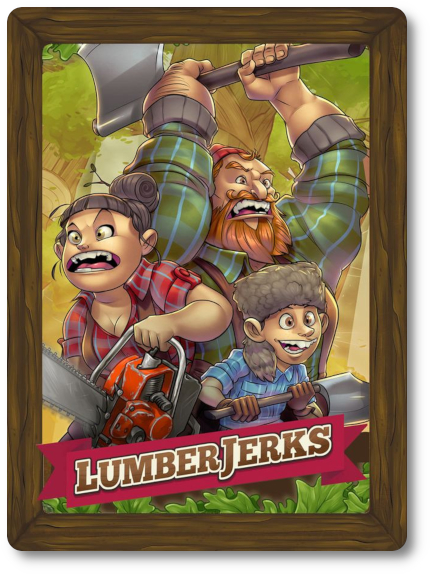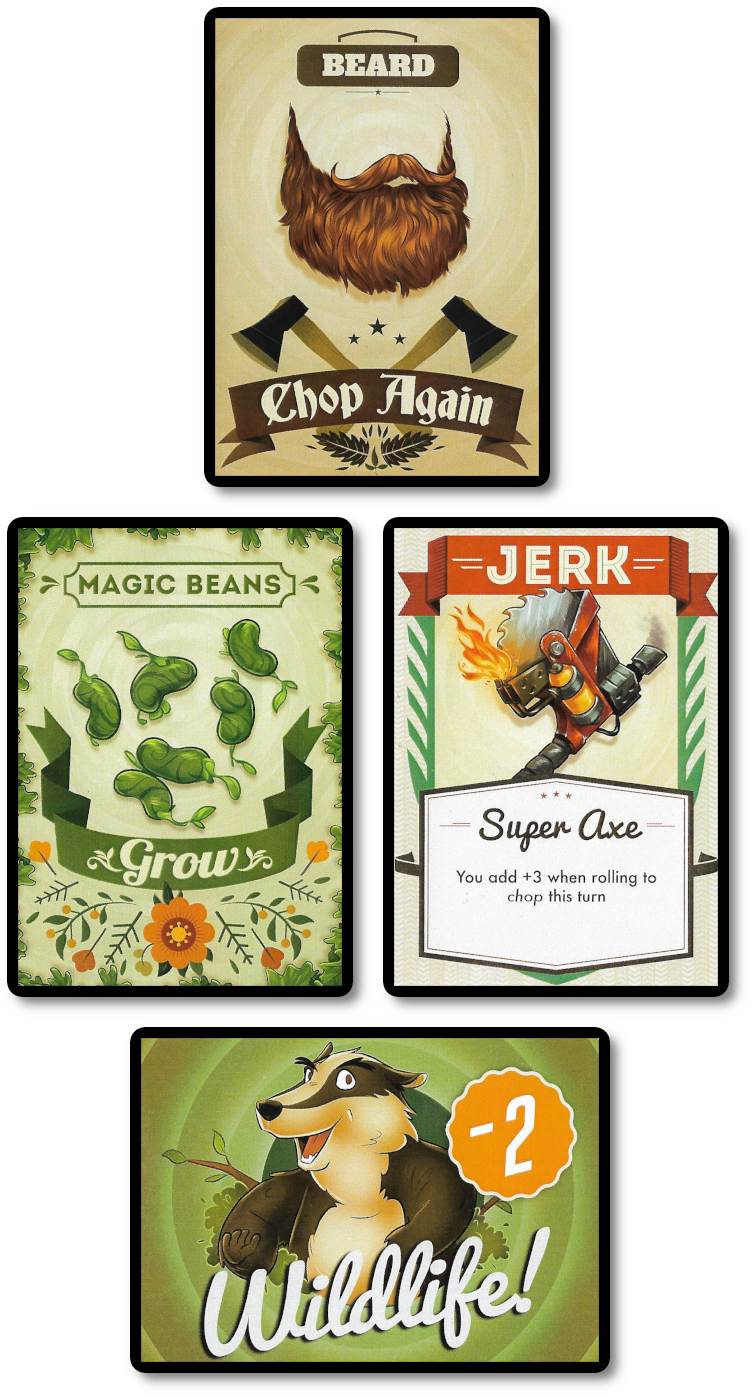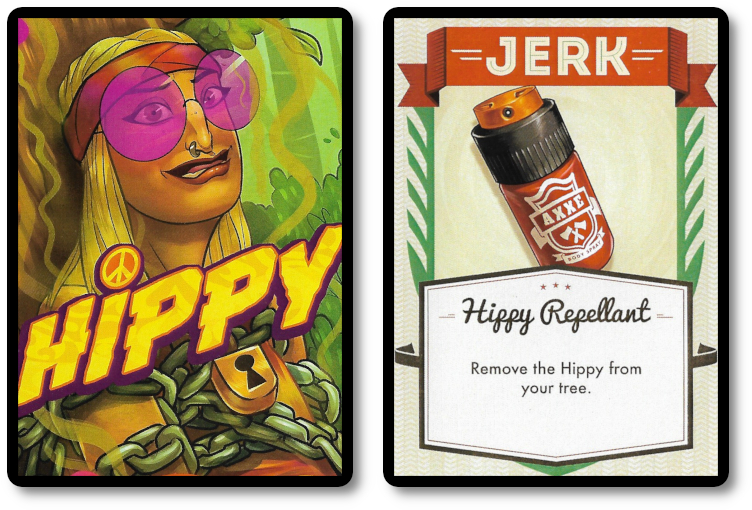Please Take Note: This is a review of the final game, but it might change slightly based on the success of the Kickstarter campaign. The game is being reviewed on the components and the rules provided with the understanding that “what you see is not what you might get” when the game is published. If you like what you read and want to learn more, we encourage you to vist the Kickstarter campaign. Now that we have all that disclaimer junk out of the way, on with the review.

The Basics:
- For ages 8 and up
- For 2 to 5 players
- Approximately 30 minutes to complete
Geek Skills:
- Active Listening & Communication
- Counting & Math
- Logical & Critical Decision Making
- Reading
- Hand/Resource Management
Learning Curve:
- Child – Easy
- Adult – Easy
Theme & Narrative:
- Chopping down trees is not for the weak-willed!
Endorsements:
- Gamer Geek rejected!
- Parent Geek approved!
- Child Geek approved!
Overview
American actor, Sean Gunn, said: “I’d always rather be a jerk than a loser.” If such is the case then Mr. Gunn would love this game! The goal is clear: cut down your tree. But, of course, it isn’t that simple. Wildlife will get in your way, dirty hippies will chain themselves to the tree, and your ax has a tendency to not cut as deeply into the wood as you would like. To win, all you need to do is chop faster and stronger than the competition, but always be a huge jerk to the other lumberjacks. Sharpen your ax and get ready to cut into the competition!
LumberJerks, designed by Dave Collinson, Alexander Delfino, Austin Mace and to be published by Howling Hog Games, will reportedly be comprised of 35 Tree cards, 30 Wildlife cards, 24 Chop Again cards, 16 Grow cards, 10 Jerk cards, 2 Hippy cards, and 1 standard six-sided green die. As this is a review of a pre-published game, I cannot comment on the game component quality. Illustrations to be used by the game, created by the talented artist Dave Collinson, are colorful and stylized, giving the game its own unique look.
Let’s Go Chop Down Trees
To set up the game, first give each player seven Tree cards. These seven cards should be arranged in front of their owning player in a column. Visually, what will result in a seven-card illustration of an enormous tree, from the large trunk at the bottom to the lofty branches above. There are two sides to the Tree cards. One shows the tree (un-chopped) and the other shows the tree cut (chopped). Numbers are provided on the Tree cards to help keep it all organized.
Second, find and set aside the Hippy and Hippy Repellent cards. These are used in a game variant.
Third, shuffle the remaining non-tree cards (comprised of Wildlife, Chop Again, Grow, and Jerk cards) into one large deck. Deal two cards to each player, face-down. These cards should remain hidden until played. Place the deck of cards face-down in the middle of the playing area. This is the draw deck for the duration of the game. Set the die next to the draw deck.
That’s it for game set up. Determine who will go first and begin!
Ax Swinging 101
LumberJerks is played in turns with no set number of turns per game. A player’s turn is separated into two phases which are summarized here.
Phase One: Chopping
This phase is all about attempting to chop down that huge tree in front of the player. This is done by taking the die and rolling it, hoping to roll the value of “3” or higher. If the roll is successful, the player takes the closest non-chopped Tree card to the “ground” and flips it to the chopped side.
If the player rolls a “6” (which is considered a critical chop…see what they did there?), the player flips the two lowest Tree cards instead of one.
Phase Two: Lumber Jerking
Yes, I cringe when I read this phase’s title, too.
The player now takes the top card from the draw deck and adds it to their hand, regardless if they successfully chopped their tree or not. The player will draw as many cards as needed to bring their hand size to three cards.
After that, the player may elect to play one card from their hand, resolves it, and then discard the played card if required. There are four types of cards to choose from.
- Chop Again: Once played, the player takes another attempt to chop down their tree. This essentially repeats the first phase of the player’s turn, but the player does not get to repeat the second phase.
- Grow: Once played, the player selects an opponent who must flip their highest chopped Tree card to the un-chopped side.
- Wildlife: Once played, the player selects an opponent and gives them their Wildlife card, which is placed next to the targeted opponent’s Tree cards. Wildlife cards reduce the value of the die rolled during phase one and will continue to do so until removed. There is no limit to the number of Wildlife cards that can be played on an opponent.
- Jerk: These cards can be played on the player’s turn or at any time during the game if applicable. Jerk cards are resolved before the game continues.

This completes the player’s turn. The next player in the turn order sequence now takes their turn by starting with phase one.
Those Pesky Animals!
As the game progresses, opponents will play Wildlife cards that will reduce the player’s ability to chop down their tree. It’s even possible that no matter what is rolled, the player will not be able to shake-off the various animals that inhabit the forest. If this is the case, the player must attempt to remove the Wildlife cards from play, which can be done one of two ways.
The first way is attempting and successfully completing the Chop phase by rolling a “3” or higher with the Wildlife penalty not changing the final value rolled to less than “3”. If the player can do this, they remove all the Wildlife cards played on their tree to the discard pile. For example, if the player rolled a “6” and they have a Wildlife card penalty of “-2”, their final rolled value is “4”, which is enough to successfully chop their tree.
The second way is to skip the player’s turn and instead focus on chasing all the wildlife away by running around, shouting, and waving their hands in the air like a crazy person. While the player does not get to chop their tree or play a card (skipping both phase one and two), they do manage to chase away all the wildlife, allowing them to discard all Wildlife cards in play on their tree. This is the only option available to the player if, mathematically, the penalty from the played Wildlife cards will always reduce the player’s final die value to “2” or less.
TIMBER!!!!
The game continues until the first player chops their seventh and final Tree cards, thus chopping their entire tree. They should shout “TIMBER!” or something like that, announcing to all their opponents that they have won the game.
Game Variants
Those dirty hippies can be used in the game if players are looking for a more challenging game experience. To do this, mix them into the deck instead of removing them during game set up. Hippy cards are played to an opponent’s tree in the same way as Wildlife cards. Unlike Wildlife cards, Hippy cards force a player to flip two chopped Tree cards to the un-chopped side when a Grow card is played against them. Luckily, only one Hippy card can be played on a player at a time, but Hippy cards and Wildlife cards can be played together.
To remove a Hippy card, the player must either roll a “6” before they reduce the rolled value from the pesky wildlife or play the “Hippy Repeleant” Jerk card. Either of these two options will allow the player to take the Hippy card and play it on an opponent’s Tree.

To learn more about LumberJerks, visit the Kickstarter campaign.
Final Word
 The Child Geeks had a great time, chopping down their trees, throwing various forest animals at each other, and chasing hippies away. According to one Child Geek, “The game is fast and I like how you can make other players have to worry about the animals instead of their trees. I liked it!” Another Child Geek said, “I liked that this was a game that I could play with my dad. He plays really hard games and I cannot play those. This was fun and I beat him two times!” When all the votes were in, the Child Geeks gave LumberJerks their full endorsement, finding the game to be fun, fast, and furious at times, but always played with a smile.
The Child Geeks had a great time, chopping down their trees, throwing various forest animals at each other, and chasing hippies away. According to one Child Geek, “The game is fast and I like how you can make other players have to worry about the animals instead of their trees. I liked it!” Another Child Geek said, “I liked that this was a game that I could play with my dad. He plays really hard games and I cannot play those. This was fun and I beat him two times!” When all the votes were in, the Child Geeks gave LumberJerks their full endorsement, finding the game to be fun, fast, and furious at times, but always played with a smile.
 The Parent Geeks found the game to be an amusing experience at their table. As one Parent Geek put it, “Normally games that force you to mess with another player can bring some of my kids to tears and irritate some of the adults, too! But not this game. It is all done with so much tongue in the cheek, that even when you are targeted, you just roll with it and smile.” Another Parent Geek said, “Good stuff for me and mine. We played it with both parents and kids mixed together. Worked great. The game was less amusing without the kids, though.” The Parent Geeks enjoyed their time with the game and gave it their approval.
The Parent Geeks found the game to be an amusing experience at their table. As one Parent Geek put it, “Normally games that force you to mess with another player can bring some of my kids to tears and irritate some of the adults, too! But not this game. It is all done with so much tongue in the cheek, that even when you are targeted, you just roll with it and smile.” Another Parent Geek said, “Good stuff for me and mine. We played it with both parents and kids mixed together. Worked great. The game was less amusing without the kids, though.” The Parent Geeks enjoyed their time with the game and gave it their approval.
 The Gamer Geeks were not impressed, but they were amused. According to one Gamer Geek, “A fun little game that I wouldn’t consider playing unless it was a filler. There isn’t enough to the game to make it worth my while and I’m not a fan of rolling the die to cut my tree down. Felt like a “roll and move” type of game where you can only move if you roll a certain number. No thanks.” Another Gamer Geek said, “Mindless but entertaining. A lot of take-that moments and swearing. Fun with our group as we drank some beers, talked sports, and waited for other folks to show up to play the big games.” The Gamer Geek voted and gave LumberJerks a thumbs down. While some believed the game was good enough to give it their thumbs up as a filler, the majority felt that the game didn’t offer enough depth of play and strategy to be of much use.
The Gamer Geeks were not impressed, but they were amused. According to one Gamer Geek, “A fun little game that I wouldn’t consider playing unless it was a filler. There isn’t enough to the game to make it worth my while and I’m not a fan of rolling the die to cut my tree down. Felt like a “roll and move” type of game where you can only move if you roll a certain number. No thanks.” Another Gamer Geek said, “Mindless but entertaining. A lot of take-that moments and swearing. Fun with our group as we drank some beers, talked sports, and waited for other folks to show up to play the big games.” The Gamer Geek voted and gave LumberJerks a thumbs down. While some believed the game was good enough to give it their thumbs up as a filler, the majority felt that the game didn’t offer enough depth of play and strategy to be of much use.
 I found the game to be a mixed bag. I’ve played games like this before, finding them amusing, but they tend to stay a bit too long at the table. Our fastest game clocked in around 10 minutes with three players and almost an hour with five players. That is way too long and way too short, but those game times are not the average. Most games will take about 30 minutes, but they will feel a bit longer. This is due to how the trees are cut. To cut a tree, the player rolls the die and the outcome of their swing is randomly determined. A player needs a “3” or higher, which gives the player a fairly high probability of swinging their ax true. However, Wildlife cards really slow a player down. As a result, the first player of the game always has the advantage as they get to take their first swing without any possibility of animals (or hippies) getting in the way. Luck plays too big a roll in my opinion, which makes the game not as interesting and most definitely frustrating.
I found the game to be a mixed bag. I’ve played games like this before, finding them amusing, but they tend to stay a bit too long at the table. Our fastest game clocked in around 10 minutes with three players and almost an hour with five players. That is way too long and way too short, but those game times are not the average. Most games will take about 30 minutes, but they will feel a bit longer. This is due to how the trees are cut. To cut a tree, the player rolls the die and the outcome of their swing is randomly determined. A player needs a “3” or higher, which gives the player a fairly high probability of swinging their ax true. However, Wildlife cards really slow a player down. As a result, the first player of the game always has the advantage as they get to take their first swing without any possibility of animals (or hippies) getting in the way. Luck plays too big a roll in my opinion, which makes the game not as interesting and most definitely frustrating.
Of course, you can always attempt to chop again with a card and I’ve seen it happen more than once where a player rolled a “6” on their first try and another “6” via a card. Good stuff, but again, always random. And while I am not a fan of random outcomes, each player’s turn is brisk and to the point. This made the gameplay tolerable, especially when I was playing with a good group of folks. Expect fast plays, grumbling, and laughter throughout. I would say that the game’s greatest strength is how easy it is to play and how easily it is to have multiple conversations with those you are playing with without upsetting the gameplay itself.
Overall, I was not disappointed with the game and didn’t find anything to be critical about. It just wasn’t my kind of game. All of my Child Geeks now gravitate to the more complex games, which makes LumberJerks a game I won’t be getting to my family table. This was not the case or beliefe by those Parent Geeks who still have younger Child Geeks or the family enjoys casual games only. For the Gamer Geeks, LumberJerks wasn’t that interesting and was quickly put aside. In all cases, the game made the player’s smile, laugh, and enjoy each other’s company. Which I would suggest makes this game about being jerks to each other an enjoyable experience. Oddly enough.
Do give this game a try if you are interested in a casual game that doesn’t take much in the way of thought, but does require a lot of patience at times. Good stuff for the casual gamers and those with Child Geeks that are too inexperienced enough to go play more complex games. Give this game a swing with your ax and find out if it’s a solid hit or a miss.
This is a paid for review of the game’s final prototype. Although our time and focus was financially compensated, our words are our own. We’d need at least 10 million dollars before we started saying what other people wanted. Such is the statuesque and legendary integrity of Father Geek which cannot be bought except by those who own their own private islands and small countries.



